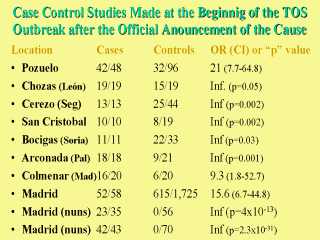| front |1 |2 |3 |4 |5 |6 |7 |8 |9 |10 |11 |12 |13 |14 |15 |16 |17 |18 |19 |20 |21 |22 |review |
 |
After completion
of these two first case-control studies, which made that Health authorities took charge of
taking the first steps in this regard , some other groups in different geographical areas
undertook case-control studies that provided similar results. In most of them, the
presence of recall bias and an ambiguous definition of the exposure were two common errors
but perhaps unavoidable in the midst of the epidemic outbreak. Despite this potential bias the results were very similar in all the studies, thus enhancing the belief that oil was the causative agent of the disease and being this fact accepted by a great majority of researchers. Doll R. The aetiology of the Spanish Toxic Syndorme: Interpretation of the epidemiological evidence. World Health Organization, editor. Copenhagen. 1985; Report nr SPA/CEH 502. 1 p. Diaz de Rojas F, Castro Garcia M, Abaitua Borda I, et al. The association of oil ingestion with toxic oil syndrome in two convents. Am J Epidemiol 1987;125(5):907-11. Canas R, Kilbourne EM. Oil ingestion and the toxic-oil syndrome: results of a survey of residents of the Orcasur neighbourhood in Madrid, Spain. Int J Epidemiol 1987;16(1):3-6. |